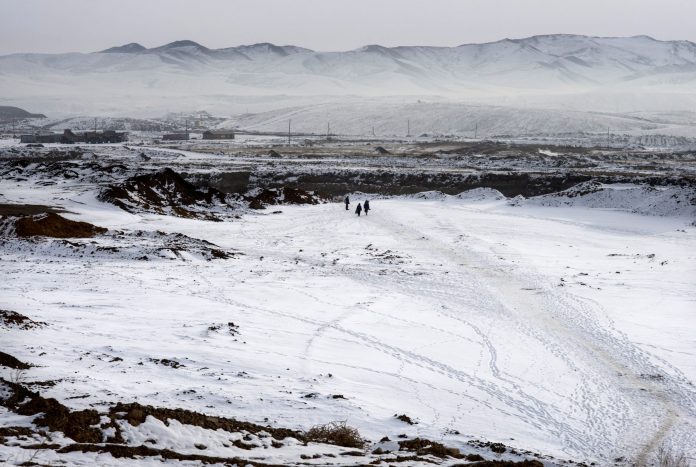Gold mining has sparked a clash between illegal diggers, artisanal mining associations and large multinationals
Text Zigor Aldama
Photos Zigor Aldama & Miguel Candela
It’s still pitch dark in the small Mongolian town of Khailaast. But Ganbold and Tungalatamir have already finished their light breakfast and are about to leave their ger – the traditional yurt of the nomads – with all the tools required to perform their illegal work. Ganbold is carrying the heavy water pump while his wife loads smaller tools into the back of their white minivan. They head for a manmade lake in the middle of the infinite steppe, where the first sunrays cover the green grass in gold… And that is exactly what the couple is looking for. They are ‘ninjas’, a nickname gold diggers get because of the large green bowl they carry on their backs, which is reminiscent of the shells of the famous comic characters in Teenage Mutant Ninja Turtles.
Different estimates put their current number at around 100,000, although the government says that at least 300,000 Mongolians have searched for gold at some point in their lives. That’s an astounding 10 percent of its total population. Different associations believe that they dig around five tons of the precious metal every year, yielding a huge amount of money that has sparked a war between legal mining companies and the ninjas. Most of the latter dig holes in the soil for further processing onsite, but Ganbold and Tungalatamir are too old for that, so they have chosen a different approach. “We are already past 60 years old and lack strength, so we process the mud at huge multinational mine discards. There, we can still find gold nuggets,” he says.

Mining for Gold
It’s a painstaking process: first, they have to dig and transport the soil to the lake, where they will pump water to separate mud from minerals. Stones are later carefully checked and, because gold is heavier, almost invisible pieces of the yellow metal will get stuck at the bottom of the bowl. It may look like dirt, but, at the end of the day, 14 hours and 15 trucks of soil later, the couple holds 9.4 grams of gold. “The price fluctuates with the market, but we normally sell it back in town at 60,000 tugriks (S$40) per gram,” Tungalatamir points out behind a scary looking cloth that protects her face from sunburn. “That’s much more than what we would earn herding animals.” And she is right: according to the World Bank, Mongolia’s GDP per capita is one of the lowest in Asia and stands at US$3,850.
It’s about 11pm when the couple heads back to town with a sweaty smile. They first stop at their ger, where they leave all the tools and change their clothes. Then they walk through the dusty unpaved streets of Khailaast to find a small grocery store where, among the sale of milk and meat, gold is an important business. The transaction is quick: the teller weighs the gold and pays in cash. Later, businesspeople from the national capital, Ulaan Baatar, as well as from neighboring countries like China and Russia, will come to buy it and smuggle it out of the country. Finally, it will find its way into legal channels, whether through jewellery or investment products, where nobody will ever know it was Ganbold and Tungalatamir who dug the metal out.
War Against the Miners
This is precisely what Amgelan Damdinragehaa is trying to fight. He is the president of a small association of artisanal mining, the type of organisation that the government decided to legalise at the end of 2013 to reduce the number of ninjas and allow people to legally benefit from the exploitation of a national resource. As opposed to what ninjas do, these artisanal miners pay their taxes and funnel their gold directly to the Bank of Mongolia, which will then add it to the national reserves. Damdinragehaa was once a ninja, so he understands their struggle, but he can’t agree with their methods.

Environmental Impact
“We are suffering major environmental degradation here,” Damdinragehaa criticises. “Ninjas dig holes up to 10 metres deep, and then they leave. Cattle fall in and die there. This sometimes look like the craters in the moon,” he says while showing a big plain full of holes partially covered in snow. “And then, our gold, a Mongolian resource, ends up in the hands of Chinese and Russian traders who pay nothing back to the country. Many are part of international mafias which may be financing harmful activities. That’s why artisanal miners are trying to convince ninjas to professionalise and work with us.” The associations have easier access to capital for the purchase of better and safer equipment, and workers are insured and can enjoy paid holidays. Most belong to the region where the mining exploitation takes place, so the whole community benefits from it.
But many don’t want to commit full-time. For most, gold digging is just a side job. Ganzorig is one of these people. He wants freedom and needs fast money, so he digs holes even when temperature drops to minus 40 degrees Celsius. “It’s not been a good day so far,” he acknowledges from the bottom of a four-metre-deep hole. “But this job is better than trading cattle,” he says later, while smoking a cigarette. And he knows what he’s talking about, because until a couple of years ago Ganzorig was one of the nomads who inhabited the northeast. Then he lost most of his herd during the winter of 2010, remembered as the terrible ‘dzud’. In the end, he decided to sell the rest and follow the advice of a friend who worked as a ninja.
As many of his colleagues acknowledge during a break, the growing numbers of gold diggers and the irruption of artisanal mining companies is a consequence of the dying tradition of Mongolian nomad herders. They now amount to less than 1 million, and many believe most will settle in a just couple of generations. Nowadays, around 40,000 do so on the outskirts of Ulaan Baatar every year. Most find misery because they lack skills for city life, but can’t return to the old ways because they’ve sold their cattle. Digging holes appears as a way out of desperation.

Policing the Miners
But D. Enkhbold feels no sympathy for them. In fact, he fights both ninjas and artisanal miners with all his might. As the president of the Mining Association of Mongolia, which represents large multinationals that have operations in the country, he believes both are prejudicial for the country. “It is clear that the ninjas are not subject to any kind of regulation and that they are especially harmful. The problem with the associations, however, is the opacity in which they operate, the lack of means to control their work, and the fact that they have some unfair tax advantages.”
In addition, Enkhbold states that “the bigger the mining companies are, the more they contribute to society through jobs and taxes or royalties. And they also care more than small businesses for the conservation of the environment.” He stresses the need to preserve the mining sector with the fact that it contributes more than 20 percent of Mongolia’s GDP – which is why many refer to Genghis Khan’s country as ‘Minegolia’ – and fuels both foreign investment and economic growth. “We need those badly if we are to transform Mongolia into a modern society where youngsters have a future beyond herding.”
What Enkhbold doesn’t want to talk about is the growing number of clashes between the companies he represents and the gold diggers. But in the central town of Zaamar, one of the gold mining hubs in Mongolia, fights are common. In fact, big companies have even hired security agents to keep ninjas at bay. Khurlee is one of such guard. He patrols a vast area that belongs to the Zaamar Gold Mining Corporation in a Land Cruiser fitted with a siren like those on police cars, and wears a camouflage uniform. When he finds them, he politely tells the ninjas to leave. But, when journalists are not present, some say guards often resort to violence.

The Future of Mongolia’s Resources
“There have been many injured and even killed in these fights,” Damdinragehaa says. “Sometimes the mines even pay corrupt policemen to get involved and arrest the ninjas. Unfortunately, there is very little we can do about it since large corporations pay big sums to corrupt politicians. They never bother to touch the gold, but they are the ones who profit most from it,” he denounces. “If we want to make Mongolia a stronger nation, we definitely need to make sure that our vast mineral resources are well managed and used to prepare future generations for the challenges of a globalised world. Unfortunately, we are not there yet.”
For more stories and photos, check out Asian Geographic Issue 120.











